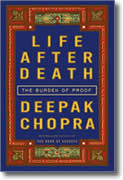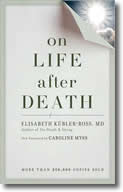Is there Life after Death?
[This short article includes a review of two new books: Deepak Chopra’s Life after Death: The Burden of Proof (releasing in paperback September ’08) and On Life after Death, by Elisabeth Kübler-Ross, with a foreword by Caroline Myss (this revised edition was published in March ’08)].
I come from a Christian background where sin, grace, and Jesus have always defined life after death. As a child I was taught that my sin was inherited at birth (this is called the doctrine of Original Sin), but Christ died and paid the penalty for my sins (this is called the doctrine of the Atonement). If I accepted his sacrifice, making Jesus the Lord of my life, I would go to heaven when it came time for me to die.Of course, most Christians will tell you that it rarely feels that simple. This basic outline seems to leave too many questions vague or unanswered. That’s where the spiritual/mystical side of Christianity comes into play. Christian mystics have always gone beyond the doctrines and focused on union with God. They teach us that union with God in this life prepares us for union with God in the next. Still, there are so many questions with so many possible answers, that Christians (and everyone in other traditions, as well) will often go looking for answers to life after death questions in other places.
Deepak Chopra is an internationally bestselling author who writes about spirituality in nonsectarian terms. He isn’t usually read by clergy and theologians—the usual experts on matters of life and death—because he talks in ways that don’t quite fit with what one might hear in church. Chopra talks about God as a universal love that has the potential to flow everywhere and in every one, but only when it is unmasked by fear, judgment, anxiety, and guilt. Since those adjectives are some real hallmarks of Christian tradition, and we’re all trying to find true love in our lives, Chopra has a lot of closet Christian readers.
Chopra has recently written Life after Death: The Burden of Proof,
in which
he presents an  approach to life after death that attempts to blend religion and
science. He shows that the universe makes sense precisely because human
beings
live and die, although death has little finality. He uses the
principles of
quantum theory to support ancient Vedic (religion native
to India, the
foundation of Hinduism) beliefs about the "consciousness"
of the universe.
Chopra explains that the whole universe and every
particle in it is conscious.
This enormous
web of all things both animate and inanimate—all with
consciousness—is
why we so often feel that life has tremendous meaning, even if
we can’t articulate it very well.
approach to life after death that attempts to blend religion and
science. He shows that the universe makes sense precisely because human
beings
live and die, although death has little finality. He uses the
principles of
quantum theory to support ancient Vedic (religion native
to India, the
foundation of Hinduism) beliefs about the "consciousness"
of the universe.
Chopra explains that the whole universe and every
particle in it is conscious.
This enormous
web of all things both animate and inanimate—all with
consciousness—is
why we so often feel that life has tremendous meaning, even if
we can’t articulate it very well.
Chopra also believes in the Vedic principle of the continuance of human consciousness after the death of the physical body (as in the doctrine of reincarnation), and explains it in Life after Death. Most interestingly, he does a good job of showing how the principles of quantum physics support this idea.
Where Deepak Chopra is a spiritual figure writing about science, Dr. Elisabeth Kübler-Ross was a scientific figure often writing about issues of spirituality. Kübler-Ross died in 2004 and will always be renowned for her groundbreaking book, On Death and Dying (1969) in which she originated the now paradigmatic "five stages of grief" for anyone experiencing tremendous loss such as learning of a terminal illness.
More recently, she published On Life After
Death, venturing
to discuss the experiences of those who have what have come to
be
called near death experiences (NDE). She spent 25
years researching what
occurs to the person at the moment of death, and
interviewing thousands of
people who have claimed to have NDE.
Most appealingly, Kübler-Ross concludes
that the NDE is
basically the same for every person.  She states this
conclusion right at
the outset, in the first essay of the book which was
originally a
lecture she gave in 1982. Just as she had earlier mapped out the
five
stages of grief, here she finds a model of sorts for near death experiences: an
out-of-the-body occurrence that includes a feeling of wholeness and
heightened
awareness; seeing doctors, nurses and/or loved ones while
clinically dead; a
feeling of never being alone, especially as our
bodies begin to die. Death is
simply a
transmission to the other side, in Kübler-Ross's findings.
She states this
conclusion right at
the outset, in the first essay of the book which was
originally a
lecture she gave in 1982. Just as she had earlier mapped out the
five
stages of grief, here she finds a model of sorts for near death experiences: an
out-of-the-body occurrence that includes a feeling of wholeness and
heightened
awareness; seeing doctors, nurses and/or loved ones while
clinically dead; a
feeling of never being alone, especially as our
bodies begin to die. Death is
simply a
transmission to the other side, in Kübler-Ross's findings.
The
findings of a Dr. Kübler-Ross have a great impact on us, I believe,
precisely
because churches and religious authorities oftentimes want
little to do with
these areas of inquiry. Why wouldn’t pastors,
priests, rabbis and theologians be
lining up to listen to the cases of
those people who were pronounced dead in a
hospital, only to revive
minutes later? Kübler-Ross claims to have studied more
than 20,000 such
cases—and her study was not detached; she actually sat at the
bedsides
of many, listening and comforting, all the while jotting down notes.
Those same religious experts who tend to want nothing to do with this
sort of
research will also usually admit that tradition or scripture
has taught them
precious little when it comes to explaining what
happens in life after death.
Chopra and Kübler-Ross conveyed a strong message of hope that there is more to life—much more—than what meets the eye. They separately conclude that the basic purpose of our lives is to learn to love and care for each other, and that in the afterwards, we will not be alone. We are like butterflies emerging from cocoons, and death from this body is really just an evolving into the next stage of life.
Copyright ©2008 Jon Sweeney